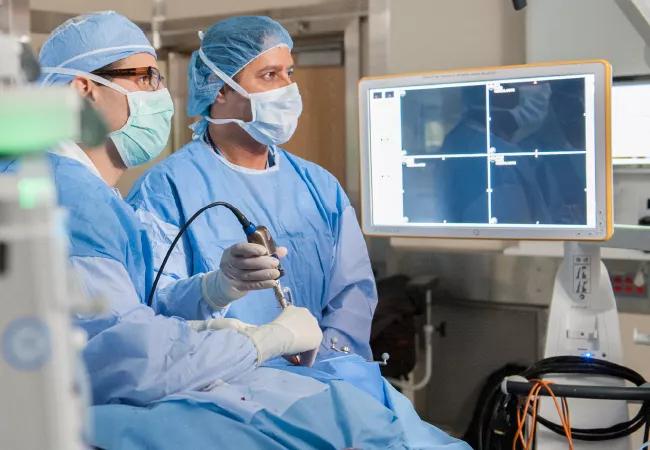Advertisement
Head & neck surgeon and neurosurgeon perform complex endonasal procedure

Endoscopic sinus and skull base surgeon Raj Sindwani, MD, and neurosurgeon Pablo Recinos, MD, partner on complex endoscopic skull base surgeries that rely on a “two surgeons, four hands” simultaneous approach rather than the tag-team approach of traditional endonasal pituitary surgery.
Advertisement
Cleveland Clinic is a non-profit academic medical center. Advertising on our site helps support our mission. We do not endorse non-Cleveland Clinic products or services. Policy
These procedures have proliferated greatly since 2014 with the launch of Cleveland Clinic’s Minimally Invasive Cranial Base and Pituitary Surgery Program, a multidisciplinary collaboration between Cleveland Clinic’s Head & Neck Institute and the Neurological Institute’s Rose Ella Burkhardt Brain Tumor and Neuro-Oncology Center.
Given the success of the two-surgeon approach, the team now routinely employs its expertise for the management of other complex pathologies located in hard to reach areas of the head. Dr. Sindwani and Dr. Recinos recently used an endoscopic, endonasal approach for resection of an intraorbital/orbital apex l hemangioma for a patient who was having severe progressive vision loss due to the mass. This was a challenging procedure due to the deep location of the tumor within the intraconal space of the eye, and because of its close proximity to the optic nerve. They selected the safest endoscopic corridor to approach the tumor (between the inferior and medial rectus muscles) and removed the mass without any cuts or bruises. The patient’s vision was restored to normal.
See how the tumor was removed and learn more about the patient’s amazing outcome in this video showing step by step how the procedure was done.
Advertisement
Advertisement

Nearly 80% of patients didn’t follow washout protocol, raising risk of misdiagnosis

Combining quantitative vessel wall MRI metrics, CSF abnormalities and neurologic symptoms can be highly predictive

Uninsured Hispanics least likely to be discharged to facility-based rehab or home healthcare

It’s time to get familiar with this emerging demyelinating disorder

Cleveland Clinic Cognitive Battery identifies at-risk patients during Medicare annual visits

An overview of associated antibodies, therapies for antibody-positive disease and the outlook for atypical forms of MG

Research to test clinical efficacy and cost-effectiveness versus standard-of-care rehab

Safety and efficacy demonstrated in largest case series reported to date